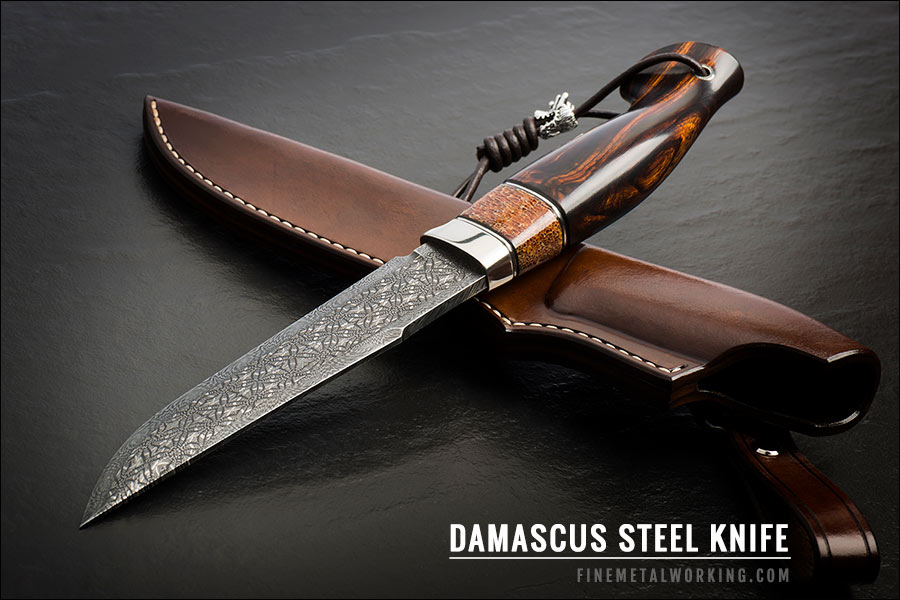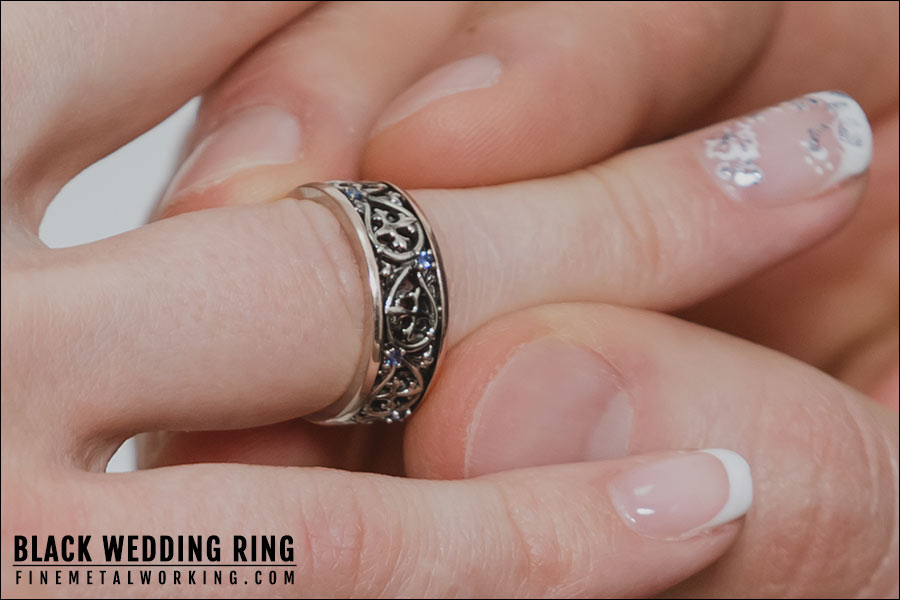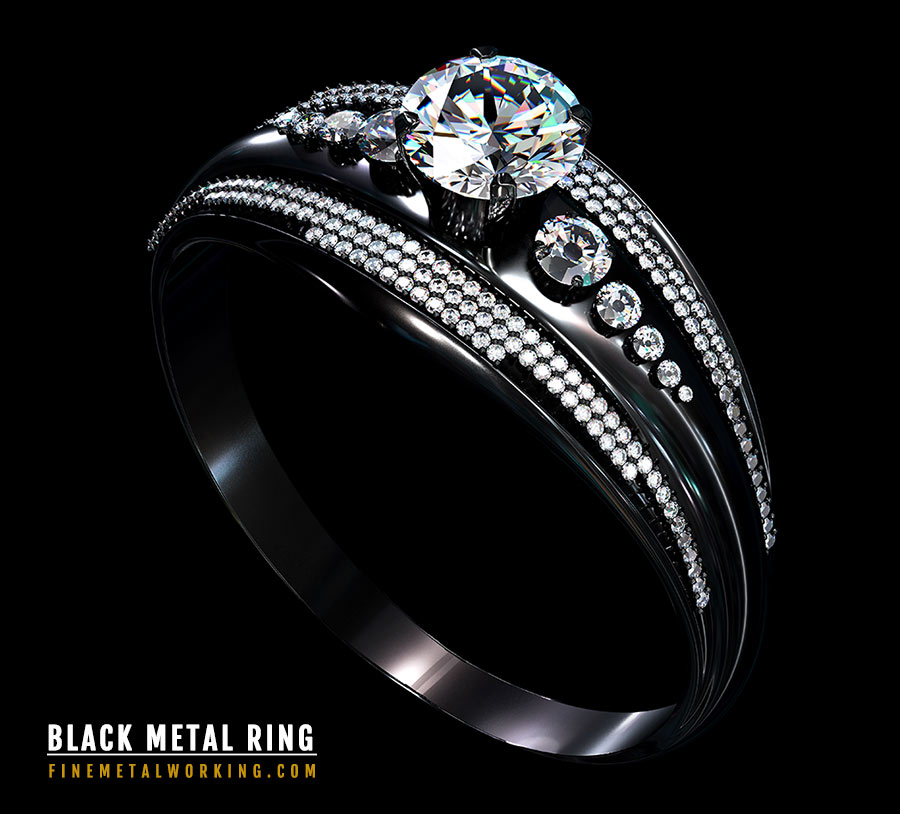Black metals are beautiful and are often used in jewelry design. These offer an elegant, unexpected aesthetic and also a pleasant break from the norm. You may ask, what are these metals, and are they naturally black, or do they undergo chemical processes that render them black?
In this article, we explore the most common metals used in creating black wedding bands, watch bracelets, and jewelry.
Page Contents
What Metals are Black Rings Made of?
In the past, rings were commonly made of gold, silver, and platinum, also known as the “big three.” We’re not limited to these anymore and can choose from a host of other metals, including beautiful black ones.
While most of these metals don’t start as black, they are treated in specific ways to make them black. A case in point is zirconium, which starts off silver (more on that later). Other black metals used in jewelry design are black titanium, anodized stainless steel, black tungsten, and Damascus steel.
Not all metals on this list are suitable for mounting gems, so if you want a ring with diamonds, rubies, or other gems, be sure to check the compatibility before choosing a material.
While Carbon fiber isn’t a metal, it’s worth mentioning that these make excellent high-quality black rings. These high-tech rings are lightweight and durable, incorporating the same materials and technology used in spacecraft. The same goes for titanium carbide, which is ceramic. This black material is used as heat shields on space shuttles.
6 Metals that are Black for Jewelry & Knives
#1. Black Titanium
Titanium is more affordable and durable than traditional black metals, such as gold and silver. Titanium isn’t naturally black – the black color comes from a specialized carbon coating process. Here, the titanium gets coated with diamond-like carbon (DLC), which forms a hard, glossy black layer. This black coating is highly scratch-resistant, making it a popular choice for people who work with their hands and want to wear their rings all day long.
The DLC layer consists of carbon atoms in the amorphous graphite atomic formation. Remember that graphite is often used as a lubricant in high-performance bearings due to its high heat resistance and low surface friction. That’s what makes this ring so smooth.
Graphite is also chemically inert, making this material ideal for use in harsh environments. Simply put, this material won’t rust, corrode, or react with any other chemicals. Another significant benefit is that this renders the material hypoallergenic.
Does titanium scratch black?
One of the bestselling points of black titanium is that its color doesn’t fade or change over time. The black titanium jewelry that you purchase today will still look the same a few decades from now. That is if you don’t scratch it.
Even though the black coating is highly scratch-resistant, under excessive conditions it eventually wears off to reveal the grey-white titanium underneath.
#2. Black Stainless Steel (Anodized)
Black stainless steel is beautiful – a great alternative to regular stainless steel and generally scratch resistant.
Note that there are two types of black stainless steel:
- Acrylic coated and
- Anodized
Acrylic Coated Stainless Steel: The acrylic coating is not quite suitable for jewelry design since it scratches off easily and requires lots of touching up. For this reason, anodized stainless steel is usually used to create black jewelry.
Anodized Stainless Steel: Anodizing is a chemical process used to change various metals’ color by increasing the thickness of the oxide layer on the metal. This process incorporates electrolytic passivation, using the metal in question as an anode in an electrolytic cell. In short, the electrolytic process causes an oxide layer to form on the metal, thus changing its color.
Stainless steel can’t technically be anodized unless you use highly corrosive chemicals at high temperatures. However, we still call the blackening process “anodizing.”
What we do to “anodized” stainless steel is black oxide coating. Here, a thin layer of black oxide is spread on the metal’s surface. This layer is heated until it reaches the desired surface finish and color intensity.
A benefit of this type of surface finish is increased wear resistance and corrosion protection.
#3. Black Gold (Black Rhodium)
Black gold, or rhodium-plated gold, is a relatively recent innovation in the jewelry market. While neither gold nor rhodium is naturally black, rhodium can be treated to appear black and then plated onto gold.
Rhodium is naturally silvery-white in color but turns black with the addition of specific additives in small quantities. Since this process is relatively new and only carried out in laboratories, the information is proprietary. We do know that technicians generally use tin sulfate, arsenic trioxide, and tellurium oxide for this purpose. Black rhodium varies in color, ranging from dark grey to deep black, depending on the blackening process.
With the newly formed black rhodium solution ready, the electroplating process starts. Here, the gold ring is dipped into the black rhodium solution and attached to an electrical current, forming an electrolytic cell. As the current passes through the ring and solution, black rhodium is deposited into the ring’s surface, much like paint or hair dye. Since the ring’s gold isn’t changed, only coated, it would require intermitted recoating to maintain its black color.
#4. Black Tungsten
Tungsten is an extremely durable, heavy metal that is naturally dark grey. To make tungsten appear black, it is surface treated with a titanium zirconium alloy, which is black. Here, specialized machinery shoots the titanium alloy particles at the tungsten at extremely high velocity, embedding these particles on the tungsten surface.
On the Mohs hardness scale, tungsten rates 8.5, while titanium rates 6. Since titanium is softer than tungsten, black tungsten rings are not as scratch-resistant as traditional tungsten rings. For this reason, black tungsten rings require intermittent recoating to maintain their color and shine. If the ring incorporates a stone setting, it can’t be recoated since this would affect the stone.
#5. Black Zirconium
Black zirconium is the only permanently black metal currently used for jewelry production. Instead of a surface coating, as is the case with other black metals, zirconium turns black through heat treatment. During this process, a layer of zirconium oxide forms, which looks and feels like ceramic.
Zirconium is hypoallergenic since it contains very few impurities that generally cause skin irritation. Another benefit is corrosion resistance since this pure metal is chemically inert. It is also lightweight and durable, rendering it highly scratch-resistant. While zirconium isn’t as hard as tungsten, it is still hard enough to prevent the metal’s deformation. This means that it won’t bend out of shape from regular wear, the way jewelry crafted from precious metal would.
When your zirconium ring gets knocked against another, softer metal, the softer metal will transfer onto the zirconium surface. This will look like a scratch but is easily removed by giving the ring a vigorous scrub with a kitchen scourer, some soap, and hot water.
#6. Damascus Steel
Damascus steel has a characteristically watery surface pattern that alternates light and dark colors. It was famously used in producing incredibly sharp and durable ancient weapons, far superior to those forged from iron. These weapons maintained their keen edge far better than their counterparts while being hard and flexible – a challenging task for any metal.

Damascus steel was originally cast from wootz, a special type of steel manufactured in India around two thousand years ago. We call this product cast Damascus steel after the process used to produce it. Unfortunately, the method for producing wootz was lost around the 17th century, and no one has to date reproduced it.
While we don’t know precisely how wootz was made, we do know that steel and iron were melted together with charcoal in an environment containing little or no oxygen (a reducing atmosphere). This environment allowed carbon to transfer from the charcoal to the steel. When this alloy was cooled slowly, a crystalline material formed containing carbide. Maintaining the correct temperature to produce this beautiful steel with its wavy patterns required considerable skill since the ancients works with fire instead of electrical ovens.
What we now know as Damascus steel is pattern-welded Damascus steel. Here, iron and steel are layered and hammered at high temperatures. This forms a welded bond, uniting the two metals into one solid piece and creating the characteristic wavy light and dark pattern. A skilled artisan can produce other patterns during this process as well.
What Metals are Naturally Black?
Zirconium is the only metal that can be considered naturally black. While there are various black metals available for creating black jewelry, it’s worth noting that most of these are not naturally black. Generally, metals are silver, gold, or grey and require surface treatment to render them black.
Zirconium is the exception to this rule since it starts as a silvery-white color but turns black when heated.
Other Black Jewelry Materials
So far, we discussed black metal jewelry. There are several non-metals that are used for making black wedding bands, watches, and other ornaments.
Two of the most popular materials are ceramic and tungsten carbide. Both these materials are extremely scratch-resistant and look very elegant when polished.
On the downside, they are difficult to machine and are very brittle compared to metals. You can fabricate carbide using conventional machines such as milling or lathe, although you can grind it with diamond wheels.
Final Thoughts
There are various black metals available to create beautiful jewelry. The one you choose depends on the object you aim to create and its intended end-use. Most black metals require periodic surface treatment or other touch-ups to maintain their black finish. That is, all except black zirconium, which is the only metal that remains permanently black.



